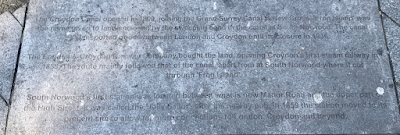There are are areas of London I don't know so well including the South east corner that forms part of Croydon. A guided tour of Stanley Arts afforded me the opportunity for a quick snoop. Quick, because this week has been unusually cold for the time of year – it was snowing when I opened the curtains on Tuesday morning, something I have never before seen in London in November. The following day, I wrapped up warm and traveled almost the full length of the soon to be renamed Overground line from Highbury and Islington to Norwood Junction.
On exiting into Station Place I was greeted by a magnificent clocktower with a weathervane on the top and some inaccessible public toilets below ground. I found out later that this clocktower has a direct link to Stanley Arts center. More later.


Cold weather has its benefits, as regards lovely blue skies! I explored the immediate area and found a ghostsign for Boots the Chemist above the convenience store on the corner of Belgrave Road...

... and a couple of nice coal hole covers bearing the name J G Stidder of Boro, SE London – that's an abbreviation for Borough in Southwark, a name and cover design I haven't seen before, even in Southwark.

Within the pavement between the Boots sign and Portland there is a panel that tells the story of the Croydon Canal which opened in 1809. I could barely read it and so took a photo to enhance it.

This canal was news to me and when I got back home I spent quite some time finding out more about it and comparing maps etc. The canal became redundant by 1836 and has since been replaced by railway lines.And so to Stanley Arts. Wow wow wow, what a building – a superb example of Edwardian exuberance.

It's slathered in the best examples of architectural styles of the 1900s – elaborate metalwork, niches for sculptures (mostly lost or stolen during decades of neglect), fired tiles (probably, I suspect, Doulton of Lambeth), moulded ceiling roses and decorative panels, carved wood and more... The building comprises three parts, basically a school, a theater and a hall. On the exterior there is a blue plaque to the man who built it and a lovely sign with a manicule directs punters to the stage. This leads into the gallery café area past a vestibule where a recessed carved panel hints at the how beautiful this building would have been a century ago.

The panel is covered in rose gold paint which I think is Hammerite, a product chosen as a quick cover-all that has also been applied to many areas in the auditorium. This paint will, over time, be removed to reveal the original plasterwork or metal underneath. To the right of the gallery entrance there is a staircase with some beautiful handrails above which sits the only remaining carved marble bust here. Strange how only this one remains being as it's almost in reach yet others that were sited in higher recesses within the hall and on the front of the building were removed. This example is exquisitely carved and I wonder who carved it and where the others are now?

In the ceiling about the gallery café area there is a repeat motif of what at first looks like a dinosaur of some kind. But look closely and see that it's a fire-breathing dragon. I doubt there's any real relevance as dragons and demons were used as decoration on many buildings during this period.

The second two pcs above are within the lovely theater space – wooden benches and a beautiful clock that reads"Time Flies / Mind your Business" which, rather than meaning 'don't be nosey' is actually reminding us that time is precious, to manage it wisely. Either side of that stage there are depictions of tragedy (as Medusa!) and comedy.

Almost every surface of the building boasts embellishments in the best products of the day. Glass, marble and fired tiles changing from deep red in the theater to green in the hall areas. The staircase up to the hall is sublime and I wonder if the fired ceramics were created by Doulton Lambeth being as the design and colours is very similar to other examples I have seen.



The final three pics with the very Art Nouveau bluebell tiles repeat are all visible from the street in the corner portico here. And, I almost forgot the clocktower – it turns out it was erected in commemoration of the Stanley's 50th wedding anniversary hinting at how well loved the couple was.
An absolute delight. I walked towards Annerley thinking to go exploring, but being as it was sooo cold I hopped on the first bus that came along which took me to Crystal Palace station. Rather than go straight home, I took the first train and enjoyed the line to Victoria followed by a wander around the backstreets of Belgravia and Knightsbridge because I recalled the was an exhibition of Underground maps I wanted to see... join me again tomorrow for that.
